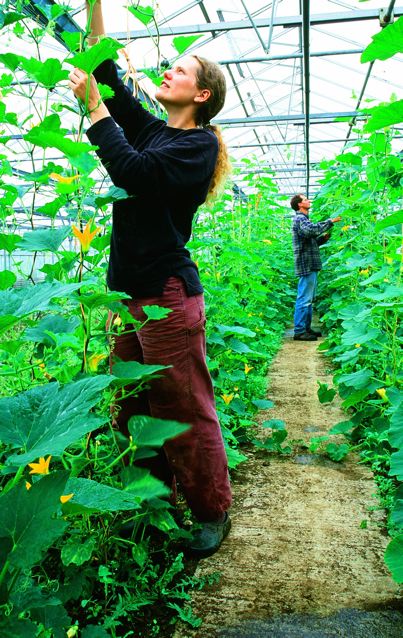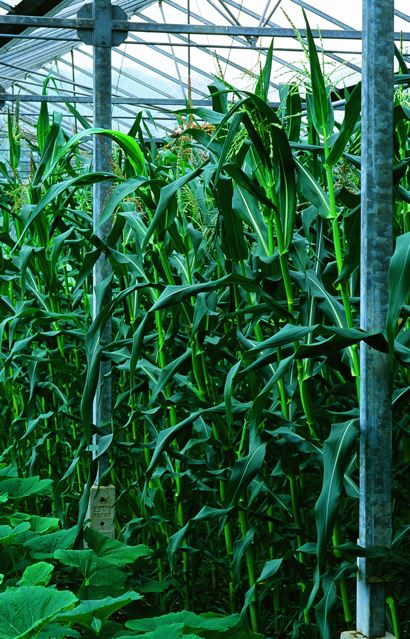It’s time to take cover: after another grey, sodden summer, the future for serious food growers looks a lot brighter under glass or plastic.
Pale, drawn and wan, sluggish, going nowhere and, ultimately, on strike: if that’s not an accurate description of how most plants in our gardens and allotments are faring this summer, I don’t know what is. On much of my own sun-starved and sodden bit of Welsh bankside, lush, healthy growth seems but a fanciful dream. As for abundance…
But there’s 144 square feet (13.75 square metres) of my garden where things are different. Yes, there’s still an inevitable hint of pallor, and a sluggardliness amid the balmy air, but at least here, in my greenhouse, plants are growing, albeit under a constraint that no mortal gardener can ever overcome: a drought of sunshine. Here, even on the dullest ‘deluge days’, it is, bar a drip or three, dry, protected from hailstone-flinging tempests, and, crucially, always at least a tad warmer than outside. Having a greenhouse (or polytunnel) lets you create a benign space in which to make an earlier start than nature often permits, grow main-season crops whose success outdoors might be marginal in a ‘normal’ summer, and then follow on with late crops for which the modest modern sunshine of autumn and winter is sufficient.

Yet this summer has been exceptional, with extreme weather affecting the fabric of many lives and precipitation breaking known records. Gardeners (as well as growers) are increasingly declaring it the worst growing year they’ve known. And it’s not just the UK: extreme weather is breaking out with unsettling frequency across the globe, as meteorologists make ever-stronger links between a warming climate and the weather which dumped over a foot (30cm) of rain on my garden in June alone.
Just how limiting this summer has been was brought home to me by my beans. My ‘Moonlight’ runner beans (which are supposed to do better in ‘poor’ summers) are yellow and weak, with not a flower bud in sight. It’s certainly been wet enough for them, and warm enough too, much of the time, but elusive sunshine, wind and unrelenting downpours have all taken their toll. Indoors, it’s a different story. Admittedly, I’m growing ‘Fasold’, a climbing French bean that’s a good doer under cover. Although growth has been laggardly, at least flowers are opening and pods are finally forming. Early, pot-grown strawberries, which would have gone to mush outdoors, salad leaves, which slugs would have decimated, and peppers, which would at best have sulked if stood out in the non-sun, have all been relative winners indoors, while the outdoor season has mostly featured water-soaked losers.
If, like mine, your long-term gardening goal is to grow as much food as possible year-round, this summer may well have toughened your resolve to plot a managed escape from the weather’s fickleness. I am – in all seriousness – considering putting as much of my garden as possible under glass or plastic. The only way to evade this climatic capriciousness – which is likely to get worse, not better – would seem to be for me and even more of my garden to, literally, take cover. This isn’t a moment of madness wrung from desperation; this drench-me-no-more ambition is inspired by a real place where my thoughts drift off to on sodden, botrytis-luring ‘summer’ days.
Near the village of Clapham, on the western edge of the Yorkshire Dales National Park, is Growing with Grace (GwG), a unique market garden that’s run ‘vegan-organically’. As well as following organic principles, the place uses no animal by-products of any sort – be it manure, dried blood or ground-up bones. This co-operative social enterprise was founded in 2000 by local people, many of them Quakers. GwG aims to develop self-sustaining ‘loops’, cutting food miles and joining up the dots; it creates all its soil fertility on site, by making compost from local kitchen and garden waste, and by growing green manures. It sells produce year-round both from its on-site shop and also through a box scheme (the delivery van is fuelled by repurposed chip fat).

But here’s the weatherproof genius of the place: everything at GwG is grown under glass in huge, unheated greenhouses covering two acres (0.8 hectares). They even make their peat-free Dales & Bowland Compost in rain-proof bliss. The greenhouses, formerly a bedding plant nursery, grow an impressive range of rotated crops in healthy, regenerated soil (which at the outset failed to muster even weeds). Beans do well here, especially runners, as do asparagus, carrots, courgettes, cucumbers, fennel, kale, onions, purple sprouting broccoli, radishes, rhubarb, spinach, squash, sweet corn, Swiss chard and tomatoes. The greenhouses have become ecosystems in their own right, complete with ponds and a resident bird population. To the team at GwG, rain never stops play – it just tops up the huge water tanks.
You can see why I’m all for taking cover, as our seasons flounder and even so-so summers – where we’d harvest at least something outdoors – begin fading into memory. At GwG, being under cover is priceless; even when the sun is elusive, the year-round shelter, higher temperatures, compost-enriched soil and ability to sow, plant and harvest at the optimum time are all key to the enterprise’s success. This is greenhouse gardening writ large, and there’s plenty we can learn from these weather-defying, hope-giving two acres, not least that it’s time to give runners a go indoors.
But as I ponder my own dash for cover, irony is heavy on the air. Human activity, through its release of greenhouse gases, is tangibly altering the nature of our shared global climate – and now, in order to bypass the weather’s fickleness, I’m (albeit reluctantly) toying with the idea of changing the nature of an increasing area of my garden. To garden well, and for it to be worthwhile, with something to show – and eat – for it, I find myself facing the idea of mobilizing my own bit of local, very deliberate climate change, as gardening’s old certainties are stripped away.
I’ve no idea how I’ll fare, or how I’ll cope when a full-on blue-sky summer finally settles over us, but I’ll never forget those two Yorkshire acres raising an impressive list of crops, come rain and shine.
Growing with Grace’s Open Day is on Saturday 15 September 2012.
Text © John Walker Images © Colin Leftley


